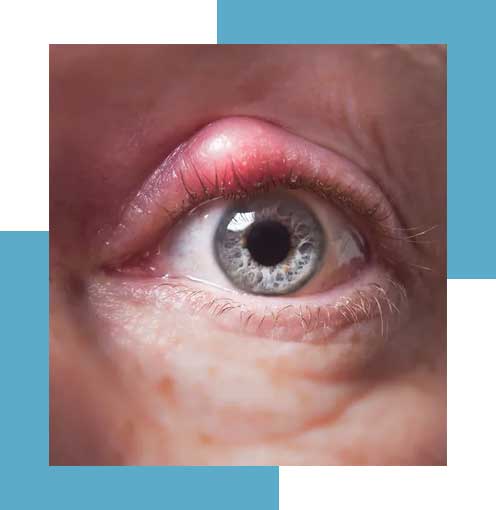Chalazion and stye
trivial pathologies, wrongly considered benign.
Chalazion, stye… What are we talking about?
Chalazion is a lesion caused by occlusion:
– one or more Meibomian glands (deep glands of the eyelid)
– or one or more Zeiss glands (smaller, more superficial sebaceous glands).
Chalazion often appears in the context of fatigue, stress, dusty environments, or when blinking is insufficient (screen, reading, driving). It starts with painless swelling of the eyelid, accompanied by a sensation of a foreign body or itching. The evolution can be brutal: signs of inflammation amplify, pain and signs of superinfection develop.
Styes are generally caused by a staphylococcal infection of the eyelash follicles. It is therefore always located on the edge of the eyelid. In rare cases, it may form in one or more Meibomian glands. This is known as an internal stye.
A stye starts with painful redness, followed by slight swelling. The eye may water, and the person affected may feel a foreign body sensation. In the case of internal styes, the pain is often greater, and the inflammation may even be accompanied by fever or chills.

Evolution and treatment
Complications are rare. The stye usually breaks after two to four days, releasing a small amount of pus, and then disappears spontaneously. 25% of chalazions also heal on their own without treatment. With treatment, their evolution is even more favorable, and the inflammation is cured in 50% of cases.
The first treatment consists of applying moist heat with a heating mask to the lesions two or three times a day. The eyelids are massaged until the cyst disappears. Local corticoids, often combined with antibiotics in the case of styes, may be prescribed. Other treatments, such as pulsed light or photomodulation, or even infiltration or incision in the most severe cases, can overcome more resistant chalazions and styes.
Not so minor pathologies…
A more detailed examination (using a meibograph, for example) often reveals that several glands are involved in chalazion, which is not immediately apparent from the clinical examination. It may also show traces of earlier episodes, suggesting a chronic pathology. Warning: repeated episodes of chalazion and stye are not to be taken lightly. Affected Meibomian glands are systematically destroyed, and this destruction is irreversible. The repetition of these events thus leads to a reduction in the glands’ meibum production capacity and a worsening of dry eye.
If these inflammatory episodes occur regularly, it’s best to turn to more comprehensive management of Meibomian gland dysfunctions, to avoid the onset of chronic pathology.
Note: chalazion can also be caused by reduced visual acuity. It is therefore necessary to have your eyesight checked (under cycloplegia in children) to establish a complete diagnosis.
